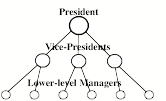brains, which are wired to arouse and suppress certain particular sets of resources.

Why would a brain be equipped with such tricks? Each of them could have evolved to promote some special important function;
If several selectors are active at once, then some resources may be both aroused and suppressed. This could lead to the kinds of mental states in which we sometimes say, “our feelings are mixed.” Thus when some of your ‘Critics’ detect some sort of threat, this might activate

I’m using ‘resource’ in a hazy way, to refer to all sorts of structures and processes that range from perception and action to ways to think about bodies of knowledge. Some resources use functions that are performed in certain particular parts of the brain, while others use parts that are more widely spread over much larger portions of the brain. (We’ll discuss this more in §§Resources).
As we said, this resource-cloud idea may seem vague—but the rest of this book will develop more detailed ideas about what our mental resources could do—and how their activities lead to the ways that people come to think and behave. Then, as we proceed to develop those schemes, we’ll replace this vague Resource-Cloud idea scheme with more elaborate theories about how our resources are organized.
In our usual, everyday views of ourselves, some of our feelings seem to be in our bodies—as when we’re affected by muscular tensions. However, our brains can’t directly detect those tensions themselves; instead, we sense signals that come up to our brains through nerves that run from those muscles and tendons. This means that we can see bodies, too, as composed of resources that brains can use.
So, instead of discussing emotions as though they were a distinctive kind of phenomenon, the rest of this book will show why it’s better to focus on what kinds of mental resources we have, what sorts of things those resources might do, how each affects the ones it’s connected to. And especially, we’ll develop ideas about what turns those resources off and on.
Indeed, certain resources are

However, a human mind cannot be so hierarchical. This is because, in general, no single, lower-level resource will be able to solve any difficult problem by itself. So when a lower-level ‘Critic’ resource encounters a problem it needs to solve, then it may transiently need to take over control of one or more high-level strategies— for example, to divide the problem into simpler parts, or to remember how a similar problem was solved in the past, or to make a series of different attempts and then to compare and evaluate these. So a

Now, each of such high-level strategies will need to use hundreds of lower-level processes, so if we tried to use several such “ways to think” at once, they would tend to interfere with each other—so we’ll still need some high level management. This could be one reason why our ‘thinking’ often seems to us more like a serial, step- by-step process than like one in which many things happen at once. However, every such high-level step will still need to engage many low-level processes that may need to work simultaneously. So the sense that our thoughts flow in serial streams must be in large part an illusion that comes because the higher-level parts of our minds know so little about those sub-processes. (We’ll discuss this more in §4 and §7.)
It’s true that we’ve only presented a caricature. To develop our Cloud-of-Resources idea, we began with a simplified version in which each resource is either switched on or off. To some degree, this might apply to some of the actions of insects and fish—and to some of what human infants do, for they are prone to strong and quick changes in state. However, in the course of growing up, we develop techniques for “self-control” and our resources become much less clearly ‘switched.’ Instead, we arouse and suppress them to different extents, so that we still can listen and speak, and to access our bodies of knowledge and skills—though we’ll use these with different priorities. And through time we develop more intricate ways to control both old instincts and new processes, and to make new kinds of arrangements of them, in which multiple ones are active at once—and that’s when we speak of our feelings as

